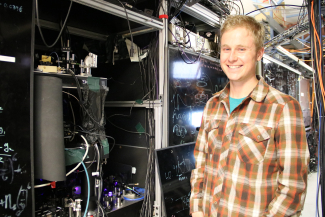JILA graduate student Alexander Aeppli is one of a team of researchers working on the world’s most precise clocks. In the laboratory of JILA and NIST Fellow Jun Ye, Aeppli focuses on improving the strontium atomic clock using powerful ultrastable lasers. “The laser drives an electronic transition in strontium,” Aeppli explained. “And we want to make sure the transition within the strontium is exact.” Before the transition occurs, the strontium atoms are trapped within an optical lattice inside the clock. Once trapped, the strontium atoms can transition when exposed to a particular color (or frequency) of light, and the researchers, like Aeppli, measure this transition frequency as a form of timekeeping. The frequency can then be used as the precise standard of time worldwide.
“We want to make sure that we're not shifting this frequency in any way,” Aeppli added. Aeppli and his fellow researchers look at external variables affecting the clock to ensure an accurate frequency in the atomic clock. “If specific conditions of our laboratory environment cause shifts of this frequency, that's bad,” he said. “That means we're not realizing the truest form of this atomic transition. So, what we've been doing over the past few years is going through and figuring out every little thing that can shift this transition, writing it down, and controlling it.” By finding external influences, Aeppli and his fellow researchers can improve their strontium clock, but also help other physicists worldwide improve their clock protocol.
As a JILA graduate student, Aeppli attends many conferences, including the 2023 Joint Conference of the European Frequency and Time Forum and the IEEE International Frequency Control Symposium in Japan. At this conference, Aeppli won a student poster competition with a presentation entitled “Towards a Systematic Accuracy Evaluation of the JILA [Strontium] Optical Lattice Clock.” As this conference focused heavily on graduate student scientific communication, awards like Aeppli’s highlighted several talented quantum physics researchers attending the event.
When speaking of his career at JILA, Aeppli felt incredibly grateful. “Everyone at JILA is great,” he stated. “The scientific infrastructure here is excellent, which includes the people. There is so much knowledge at JILA. There are many people to talk to who can answer your questions about science. The electronics shop, computing, or machine shop all have a wealth of experience. It's busy with all the science going on.”
Written by Kenna Hughes-Castleberry, JILA Science Communicator



 The Physics Frontiers Centers (PFC) program supports university-based centers and institutes where the collective efforts of a larger group of individuals can enable transformational advances in the most promising research areas. The program is designed to foster major breakthroughs at the intellectual frontiers of physics by providing needed resources such as combinations of talents, skills, disciplines, and/or specialized infrastructure, not usually available to individual investigators or small groups, in an environment in which the collective efforts of the larger group can be shown to be seminal to promoting significant progress in the science and the education of students. PFCs also include creative, substantive activities aimed at enhancing education, broadening participation of traditionally underrepresented groups, and outreach to the scientific community and general public.
The Physics Frontiers Centers (PFC) program supports university-based centers and institutes where the collective efforts of a larger group of individuals can enable transformational advances in the most promising research areas. The program is designed to foster major breakthroughs at the intellectual frontiers of physics by providing needed resources such as combinations of talents, skills, disciplines, and/or specialized infrastructure, not usually available to individual investigators or small groups, in an environment in which the collective efforts of the larger group can be shown to be seminal to promoting significant progress in the science and the education of students. PFCs also include creative, substantive activities aimed at enhancing education, broadening participation of traditionally underrepresented groups, and outreach to the scientific community and general public.